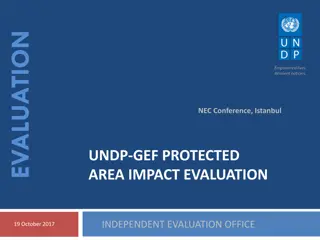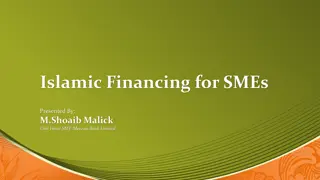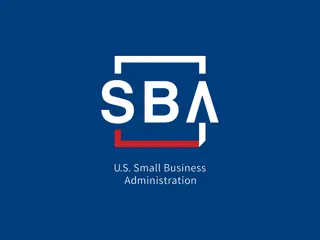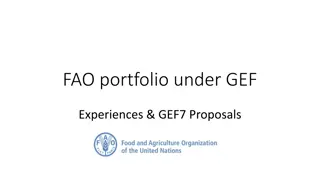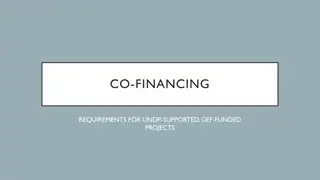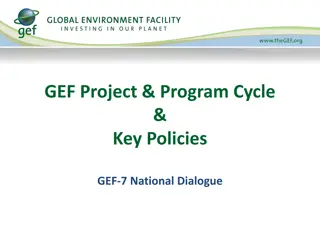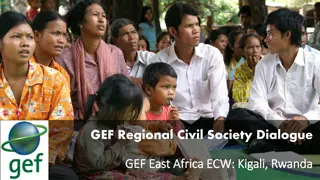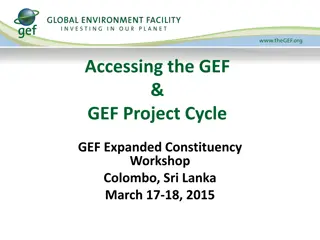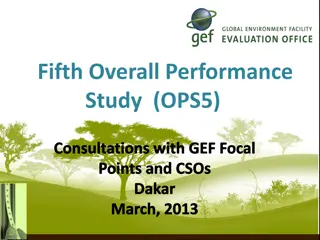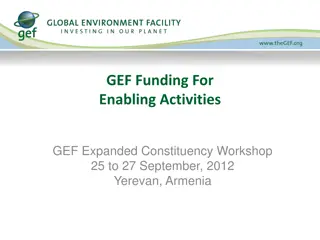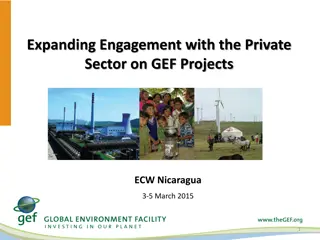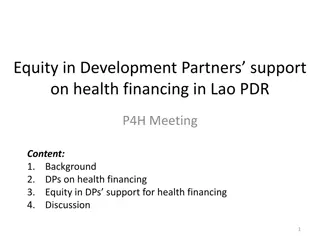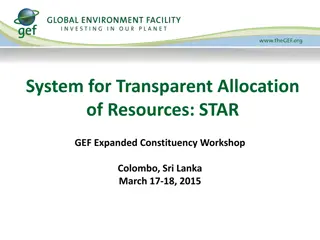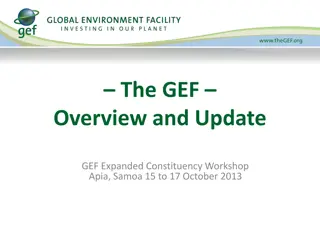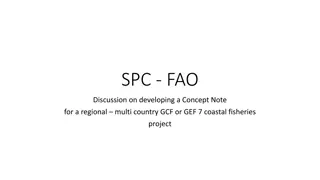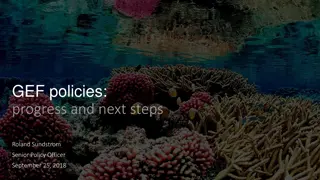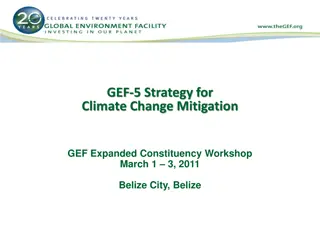Understanding GEF Project Cycle and Financing
This content explains the accessing of the Global Environment Facility (GEF) and its project cycle, including acronyms used, GEF financing objectives, eligibility criteria for project proposals, accessing the GEF Trust Fund through traditional and direct modes, and types of GEF projects based on grant size. It covers key aspects such as project alignment with national priorities, stakeholder involvement, and the role of GEF Operational Focal Points.
- GEF Project Cycle
- GEF Financing
- Project Proposal Eligibility
- Global Environmental Benefits
- Direct Access Mode
Download Presentation

Please find below an Image/Link to download the presentation.
The content on the website is provided AS IS for your information and personal use only. It may not be sold, licensed, or shared on other websites without obtaining consent from the author. Download presentation by click this link. If you encounter any issues during the download, it is possible that the publisher has removed the file from their server.
E N D
Presentation Transcript
Accessing the GEF and the GEF Project Cycle GEF Expanded Constituency Workshop Managua, Nicaragua March 3-4, 2015
Acronyms Used in this Presentation FSP = Full-Sized Project MSP = Medium-Sized Project EA = Enabling Activities PA = Programmatic Approach MIA=Minamata Convention Initial Assessment ASGM NAP = Artisanal and Small Scale Gold Mining National Action Plan PIFs = Project Identification Form/concept of a project PFD = Program Framework Document PPG = Project Preparation Grant
GEF Financing Financing Objective: to provide resources to recipient countries to meet the agreed incremental cost of activities that generate global environmental benefits (GEBs). GEF Trust Fund, Least Developing Countries Fund (LDCF), Special Climate Change Fund (SCCF) & Nagoya Protocol Implementation Fund (NPIF). Who can apply? A GEF country member government, any eligible individual or group may propose a project through the OFP. GEF Operational Focal Point (OFP) plays a key role in assuring that GEF projects are aligned to meet the needs and priorities of the respective country.
Eligibility of Project Proposal A project proposal has to fulfill the following criteria for consideration for GEF financing, : It is undertaken in an eligible country and is consistent with country s national priorities and programs. It addresses one or more of the GEF Focal Area objectives in improving the global environment or advancing the prospect of reducing risks to it. It is consistent with the GEF operational strategy. It seeks GEF financing only for the agreed incremental costs on measures to achieve global environmental benefits It involves the stakeholders in project design and implementation. It is endorsed by the government(s) of the country/ies in which it will be implemented.
Accessing the GEF Trust Fund TRADITIONAL MODE Project proponents work closely with national GEF Operational Focal Points (who formally endorse project concepts) and the GEF Partner Agency, to develop concepts and move through the project cycle and are approved either by the GEF Council or the GEF CEO, depending on the type of project. DIRECT ACCESS MODE In response to country request to improve country ownership, country drivenness and capacity building Project proponents work directly with the GEF Secretariat without going through a GEF Agency; projects follow the same project eligibility criteria and focal area strategic objectives.
Types of GEF Projects GEF project types by Grant Size: Full-Sized Projects (FSPs): GEF grant > $2 million Medium-Sized Projects (MSPs): GEF grant < $2 million Enabling Activities (EAs): GEF grant is capped by respective focal area threshold: Biodiversity and Climate Change = up to $500,000; Land Degradation = up to $150,000 Chemical and Waste (MIA = $200,000; Persistent Organic Pollutants and ASGM NAP=$500,000) Programmatic Approach (PA) Small Grants Program (max $50,000) MIA=Minamata Convention Initial Assessment ASGM NAP = Artisanal and Small Scale Gold Mining National Action Plan
Project Cycle Steps Two major approval steps for Full-Sized Projects: Council and the GEF Secretariat: 1. Council approval of work program 2. CEO endorsement of the project document GEF Agency: 1. Approval of the project by the GEF Agency and implementation start; 2. Completion of implementation, terminal evaluation and financial closure.
Full-Sized Project Cycle Council approval of Work Program* Project CEO implementation and continues to completion*** endorsement of project GEF Agency approval of project** Work Program consists of PIFs cleared by the CEO * ** GEF Agency approval of project signifies start of project implementation *** Project completion follows terminal evaluation and financial closure
Medium-Sized Project Cycle One-step approach, preferred: Final MSP request and project document submit to the Secretariat for CEO approval, on a rolling basis. As needed, a PPG of up to $50,000 can be requested with MSP submission. Two-step approach, only if required: Submission of a PIF with PPG request, if needed Submission of a final MSP document plus a MSP Approval Request for CEO approval
Enabling Activities Project Cycle Enabling Activities follow two paths: Direct Access (follow direct access policy applies the World Bank Operations Policies and Procedures): Country applies directly to the Secretariat for funding Regular procedures : Country works with a GEF Partner Agency to access funding.
Programmatic Approach Cycle The new programmatic approach: approved by Council approval in the October 2014 Council meeting. Steps include: Council approval of a Program Framework Document (PFD) included in a work program; CEO endorsement of fully prepared child projects under the program
Features of a Program Key document: Program Framework Document (PFD). All child projects under the Program have to be submitted for CEO endorsement by a deadline (or Program Commitment Deadline) agreed by relevant stakeholders during the preparation of the program concept or PFD. Child projects can apply for project preparation funding through submission of a PPG Request.
Project Review Criteria Country eligibility and ownership Global Environment Benefits GEF Focal area strategy Agency s Comparative advantage Resource availability Project consistency Project design Project financing and co-financing Monitoring and evaluation; and Agency s responses to comments and reviews.
Country Endorsement Endorsement by a national Operational Focal Point (OFP) is a requirement for the following: all PIFs to enter the work program, and for application of Project Preparation Grants (PPGs); PFDs submitted for work program inclusion; Request for CEO approval of MSP final projects; All EAs requesting CEO approval. Projects in biodiversity, climate change, and land degradation focal areas also follow STAR rules.
Recent Council Papers on Project Cycle Please consult the GEF website: www.thegef.org for all relevant project cycle papers for more detailed policies and procedures. To name a few: GEF/C.31/7/Corr.1 GEF Project Cycle (Corrigendum) English GEF/C.38/05/Rev.1 Streamlining the Project Cycle and Refining the Programmatic Approach GEF/C.39/Inf.03 GEF Project and Programmatic Approach Cycles English English English English GEF/C.43/06 Streamlining of Project Cycle GEF/C.47/07 Improving the GEF Project Cycle
System for Transparent Allocation of Resources: STAR GEF Expanded Constituency Workshop Managua, Nicaragua March 3-4, 2015
Outline Background The Workings of the STAR model An Example Calculation A Short Quiz!
Background The current mechanism by which GEF resources are allocated to countries in three focal areas Biodiversity, Climate Change, and Land Degradation The Resource Allocation Framework (RAF) was the first PBA for the GEF and adopted for GEF-4 The STAR updated the RAF and was implemented for GEF-5 The STAR was recently updated for GEF-6
Objectives STAR aims to allocate scarce GEF resources within and among focal areas in order to: maximise impact on the global environment promote sound environmental policies and practices meet convention requirements match country driven priorities
Calculating STAR Allocations Determine Available Focal Area Funds 1 Calculate Country Scores 2 Calculate Preliminary Country Allocations 3 Adjust for Floors and Ceilings 4 Obtain Final Allocations 5 Determine post-allocation Flexibilities 6
Available Focal Area Funds Total Envelope Focal Areas STAR Focal Areas less Set Asides Country Allocations
Calculating STAR Allocations Determine Available Focal Area Funds 1 Calculate Country Scores 2 Calculate Preliminary Country Allocations 3 Adjust for Floors and Ceilings 4 Obtain Final Allocations 5 Determine post-allocation Flexibilities 6
The Main Indices Global Benefits Index: measures a country s relative share of GEF potential benefits that can be generated by a fixed amount of resource input into a focal area Country Performance Index: measures a country s performance and capacity to deliver potential global environmental benefits GDP Index: designed to increase allocation of countries with a low GDP per capita
The Country Score COUNTRY SCORE Global Benefits Index Country GDP Index Performance Index Land Biodiversity Climate Change Degradation Country Score = GBI0.8 CPI 1.0GDP-0.08
Calculating STAR Allocations Determine Available Focal Area Funds 1 Calculate Country Scores 2 Calculate Preliminary Country Allocations 3 Adjust for Floors and Ceilings 4 Obtain Final Allocations 5 Determine post-allocation Flexibilities 6
Preliminary Country Allocations Country Share = Country Score / Sum of Country Scores for all eligible countries Preliminary Allocation = Country Share * Available Focal Area Funds
Calculating STAR Allocations Determine Available Focal Area Funds 1 Calculate Country Scores 2 Calculate Preliminary Country Allocations 3 Adjust for Floors and Ceilings 4 Obtain Final Allocations 5 Determine post-allocation Flexibilities 6
Floors and Ceilings Floor for LDCs 3 2 Floor Ceilings (US Mn) 126 129.6 Focal Area Ceiling % for Non LDCs 2 1.5 Climate Change Biodiversity Land Degradation 10% 10% 1 0.5 10% 43.1
Calculating STAR Allocations Determine Available Focal Area Funds 1 Calculate Country Scores 2 Calculate Preliminary Country Allocations 3 Adjust for Floors and Ceilings 4 Obtain Final Allocations 5 Determine post-allocation Flexibilities 6
Final Allocations Adjustments for floors and ceilings mean there is a surplus or deficit relative to the preliminary allocation This is then allocated among countries using the country scores Process iterates until the full amount has been allocated among countries
Calculating STAR Allocations Determine Available Focal Area Funds 1 Calculate Country Scores 2 Calculate Preliminary Country Allocations 3 Adjust for Floors and Ceilings 4 Obtain Final Allocations 5 Determine post-allocation Flexibilities 6
Flexibilities and Marginal Adjustments Flexibilities relate to the utilization(not allocation) of GEF resources Countries are allowed to adjust their focal area allocations (but not their total envelope) Total Allocation X Allowed Marginal Adjustment X 7 million unlimited X > 7 million 2 million
Approximate Calculation: Trinidad and Tobago BIODIVERSITY CLIMATE CHANGE LAND DEGRADATION GBI 0.21 0.12 0.30 CPI 3.65 GDPI 17934.06 COUNTRY SCORE (GBI0.8 CPI 1.0GDP-0.08) 0.48 0.306 0.63 SUM OF COUNTRY SCORES 174.45 147.30 189.39 COUNTRY SHARE 0.002753 0.00208 0.00333 FOCAL AREA ALLOCATION 1051 941 346 PRELIMINARY COUNTRY ALLOCATION 2.89 1.96 1.15 FINAL COUNTRY ALLOCATION 2.78 2.29 1.14 TOTAL ALLOCATION = 6.22 MILLION (FULLY FLEXIBLE COUNTRY)
Question Country A has the following STAR allocations: Biodiversity = 3 million Climate Change = 4 million Land Degradation = 1 million (a) Does this country have full flexibility in the use of its resources? Why, or why not? (b) Is this country allowed any marginal adjustment across focal areas? If so, how much?
Question Country B is an LDC. During the STAR model simulations, Country B has preliminary allocations as follows: CLIMATE CHANGE LAND BIODIVERSITY DEGRADATION PRELIMINARY ALLOCATIONS 1.7 2.4 0.8 Comment on these values. (hint floors!)
Floors and Ceilings Floor for LDCs 3 2 Floor Ceilings (US Mn) 126 129.6 Focal Area Ceiling % for Non LDCs 2 1.5 Climate Change Biodiversity Land Degradation 10% 10% 1 0.5 10% 43.1
Question During the STAR model simulations, Country C has preliminary allocations as follows: CLIMATE CHANGE LAND BIODIVERSITY DEGRADATION PRELIMINARY ALLOCATIONS 135 140 40 Comment on these values. (hint ceilings!)
Question Given the following values, calculate the Country Scores for Country D for each of the three focal areas. CLIMATE CHANGE 0.05 LAND BIODIVERSITY DEGRADATION 0.08 GBI 0.04 CPI 3.25 GDPI 13000 COUNTRY SCORE ? ? ?
. Thank you for your attention! Questions?



